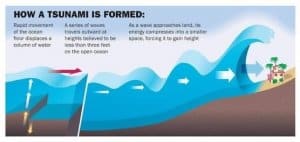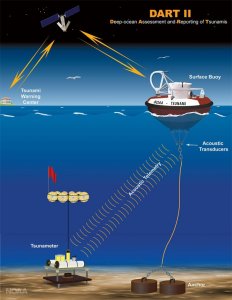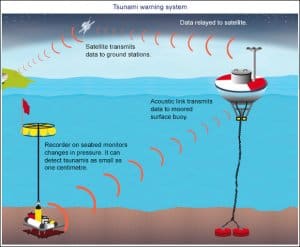The seismic waves traveling through the ocean and seawater results in high sea waves which are known as tsunami.
- ‘Tsunami’ is a Japanese term represented by two characters: “tsu” and “nami”. The character “tsu” means harbor, while the character “nami” means wave. which has been universally adopted to describe a large seismically generated sea wave.
- These waves are responsible for causing considerable destruction in certain coastal areas where submarine earthquakes occur.
- It is a series of waves of extremely long wavelengths and long periods generated in a body of water by an impulsive disturbance that displaces water.

For a Tsunami to occur, two conditions are required:
- There should be an earthquake from which energy can be transferred.
- There should be a vertical displacement of the water. i.e. during an earthquake, the crust should move vertically. That’s why Tsunamis are originated near oceanic trenches where plates are being subducted. In the Atlantic Ocean, a number of earthquakes occur on the Mid–Oceanic ridge but since there is no sudden vertical movement, Tsunamis are not formed. Tsunamis can also be triggered if the seamounts break. This can cause a vertical displacement of water.
Process of Generation of Tsunami:
- When a tsunami is generated, its steepness i.e. height to length ratio is very less.
- This enables it to pass unnoticed beneath the ships in the sea. As the wave approaches the shore, the height of the wave rapidly increases because of the rebound from the shallow surface.
- The period of the wave remains constant, velocity drops, and the height increases. In confined coastal waters relatively close to their point of origin, tsunamis can reach a height of more than 30m. Tsunamis travel at the speed of 100 -150 km/h which may pick up 650-900 km/h.
- When the tsunami enters the shoaling water of coastlines in its path, the velocity of its waves diminishes, and the wave height increases.
- As a tsunami leaves the deep water of the open sea and propagates into the more shallow waters near the coast, it undergoes a transformation.
- Since the speed of the tsunami is related to the water depth, as the depth of the water decreases, the speed of the tsunami diminishes.
- The change in the total energy of the tsunami remains constant. Therefore, the speed of the tsunami decreases as it enters shallower water, and the height of the wave grows.
- Because of this “shoaling” effect, a tsunami that was imperceptible in deep water may grow to be several feet or more in height.
- It may travel a considerable distance. The frequency of tsunami is highest in the Pacific Ocean.
- Since 1948, an International Tsunami Warning Network has been in operation around the Pacific Ocean to alert coastal residents to possible danger.
Causes of Tsunami
- EARTHQUAKE
- LANDSLIDES
- UNDERSEA VOLCANOES
- METEORS, ASTEROIDS
- ANTHROPOGENIC FACTORS LIKE NUCLEAR EXPLOSIONS
Tsunami Early Warning System
- Since science cannot predict when earthquakes will occur, they cannot determine exactly when a tsunami will be generated. But, with the aid of historical records of tsunamis and numerical models, science can get an idea as to where they are most likely to be generated.
- Hence, the only way to effectively mitigate the impact of a tsunami is through an early warning system.
- Tsunamis are detected in advance using a tsunami warning system (TWS) and early warnings are issued to safeguard the life of people. It is made up of two equally important components: a network of sensors to detect tsunamis and a communications infrastructure to issue timely alarms to permit evacuation of the coastal areas.

- Tsunamis are detected in advance using a tsunami warning system (TWS) and early warnings are issued to safeguard the life of people. It is made up of two equally important components: a network of sensors to detect tsunamis and a communications infrastructure to issue timely alarms to permit evacuation of the coastal areas.
- There are many regional and international early warning systems installed all across the globe.
- National governments warn citizens through a variety of means, including SMS messages, radio and television broadcasts, and sirens from dedicated platforms, mosque loudspeakers, and police vehicles with loudspeakers.
- India had volunteered to join the International Tsunami Warning System after the December 2004 tsunami disaster.
- The Indian Tsunami Early Warning Centre (ITEWC) embedded with specific systems called Deep Ocean Assessment and Reporting of Tsunamis (DART), established in 2007 at the Indian National Centre for Ocean Information Sciences, (INCOIS – ESSO) Hyderabad, an autonomous body under the Ministry of Earth Sciences, is up and running to provide tsunami advisories for the events occurring in the global oceans.
- It has been recognized as one of the best systems in the world. The ITEWC includes a real-time seismic monitoring network of seventeen broadband seismic stations to detect tsunamigenic earthquakes and to provide timely warnings to the vulnerable community. It also receives earthquake data from all other global networks to detect earthquakes (of M6.5).
- Since its inception in October 2007, so far ITEWC has monitored 339 earthquakes of M 6.5. ITEWC also acts as one of the Regional Tsunami Advisory Service Provider (RTSP) along with Australia & Indonesia for the Indian Ocean region.


sir your notes are really good and in a well organised way .pls upload remaining topics
Sure
Too amazing notes. Thanks a lot 😍